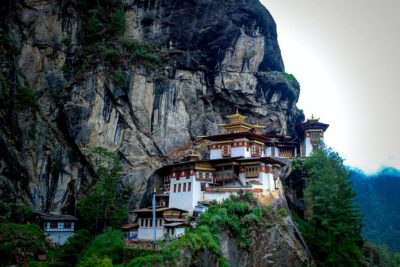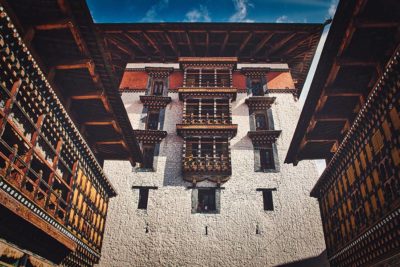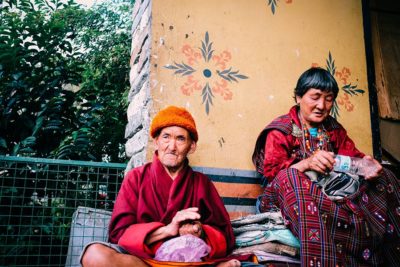Heritage-Luxury experience in Bhutan
12 days
This exclusive itinerary – that we like to call heritage luxury experience – has been carefully crafted by Conscious Journeys’ experts in each destination for a particularly local and one-of-a-kind experience. In designing this itinerary, we worked in close collaboration with local hotel owners, who are passionate about their localities, which they call home. In this way this tour become a life-time experience which allow you to discover secret spots, traditional art, culture, activities and cuisines of each destination. This itinerary has been designed through personal experience, first-hand knowledge and trusted recommendations from a local’s perspective, offering you unique holidays in Bhutan that go well beyond the typical touristic itinerary. We have curated signature experiences in all destinations while “living” in unique heritages properties which are evocative and will allow you to experience a true sense of cultural heritage, within the warmth and attention to detail typical of Bhutanese hospitality. Therefore, with our carefully curated selection of exclusive properties and activities throughout Bhutan, this tour will offer you an unique and exclusive holiday. Our resort and lodges are more than a place where to sleep…But very special locations where you can live unique experiences!
This itinerary is thought as to experience and visit the holy sites of Bhutan that were blessed by Guru Rinpoche during his long journey from India to Tibet in the 8th Century and to get to explore the cultural and ecological richness of Bhutan, while at the same time having the opportunity to stay in the best heritage hotel available in each destination. Bhutan, unlike its other Himalayan neighbours, considers all creation sacred, including trees, mountains, rivers, and lakes. Consequently, Himalayan species near extinction in the bordering countries of Nepal, India, and Tibet are doing well in Bhutan. Bhutan is also the last bastion of Vajrayana Buddhism, a spiritual practice that is known to be one of the most profound schools of teaching in the Buddhist world. The sacred monasteries, the fluttering prayer flags that line the high ridges, the red robed monks chanting their prayers — all give this kingdom an aura of another time. This is BHUTAN: Known to its inhabitants as Druk Yul — “the Land of the Thunder Dragon. The culture remains vibrant and the environment pristine as Bhutan continues to thrive in the 21st-century. Apart from the majesty and grandeur of the natural surroundings, the environment allows communion with the divine through meditation and contemplation. Bhutan is an abode of Buddhist deities, immortals, and saints in the Himalayas. Scholars wandering yogis, saints and lay pilgrims, have been irresistibly drawn to these remote and rugged mountains throughout the centuries in their search for wisdom and inspiration. Experience the landscapes they have blessed for all pilgrims by following in their footsteps. As you travel to these hidden holy shrines and otherworldly ancient monasteries (Gompas), hiking through an unspoiled Himalayan environment, you will rediscover this peace and solitude. The scared Paro Taktshang, Tiger Nest is blessed during 7th century, by the great tantric master, Guru Rinpoche, who came here by his miraculous, flying on the back of flaming tigress in form of Guru Dorje Drolo from Khenpajong (eastern Bhutan) on the way from Tibet, to advocate the Buddhism teaching in Mon-Yul (place of darkness). Here, he meditated almost three months and blessed with numerous of Neys (holy site), subdued and activated the evil deities as Buddhism protectors and even the whole locality was also turned into Buddhist. From Pemayangtse monastery, meaning perfect sublime lotus, the beautiful Khachopelri monastery, the unique Bon Monastery of Kewzing and finally to the famous, majestic Tiger’s Nest (Taktsang) balanced among the clouds high above Paro, blessed by Guru Padmasambhava himself, this journey provides a true insight to the rich culture and religiousness of Bhutan. With this special itinerary, you will have the chance to discover the real essence of this country, with its breathtaking landscapes, natural treasures, and stay in some of the most beautiful heritage resorts. These resorts represent the best accommodation you can find in every city you will visit: it is not only a peaceful stay surrounded by all comforts, but these also special places where you can restore your physical and mental balance.
JOURNEY OVERVIEW AND PROGRAM DETAILS
DAY 1: ARRIVAL IN KOLKATA
Kolkata
Arrival at Calcutta international airport. Transfer to hotel for refreshing and rest. Kolkata, formerly Calcutta, is the capital of the Indian state of West Bengal. Located on the east bank of the Hooghly River, it is the principal commercial, cultural, and educational centre of East India, while the Port of Kolkata is India’s oldest operating port as well as its sole major riverine port. As the former capital of British India, Kolkata retains a feast of colonial-era architecture contrasting starkly with urban slums and dynamic new-town suburbs with their air-conditioned shopping malls. Afternoon short city tour which also includes a country boat ride on the Ganges to experience the glorious sun set.
Overnight in Kolkata (D)
DAY 2: JUNGLE SAFARI IN GORUMARA NATIONAL PARK
Kolkata – Bagdogra – Dooars
Early morning flight to Bagdogra. On arrival transfer to a forest resort in Dooars. (around 2 hours). Refreshments will be served upon arrival. Check-in to the room, followed by Lunch. Later Embark on an afternoon jungle safari in Gorumara National Park to view some of the wildlife inhabiting the region – one-horned Indian Rhino, Elephant, Gaur (Indian Bison) as well as a variety of endemic and migratory birds. After the jungle safari reurn to the hotel for dinner.
Overnight in Doars (B/L/D)
DAY 3: TRANSFER TO BHUTAN
Doars- Punshotling -Thimpu
After an early breakfast drive to Phuentsholing, the Gateway to Bhutan from India, pass by terraced fields and tea gardens. Here you can purchase souvenirs of their visit from local shop. You can try some local delicacies for lunch in Phuentsholing. Here our Bhutanese guide will meet you. Travel to Thimpu (167 km about 4,30 hrs). Leaving the city of Phuentsholing you will heading towards cool and clean air, the road climbs to a higher elevation as you will experience the thin air of the high Himalaya, drive pass Kharbandi Gomba, overlooking the border town of Jaigon and Puntsholing. In a couple of hours drive you will reach Chhukha. There you will see hydro projects, which generates 1020MW of electricity by the Wang Chhu River. You will come across the immigration check point before you climb the Chapcha Village. After crossing the pass, the road drops quickly and follows the upper Wangchhu river, after which your drive becomes much comfortable road till Thimpu. Check in the hotel and rest. You will have the possibility to undergo a traditional Bhutanese hot stone bath.
Overnight in Thimpu (B/L/D)
DAY 4: THIMPU
Thimphu
Early morning, participate in a yoga and meditation session at the resort. After breakfast, you will take a short drive to Choki art and craft center in Kabisa and also you will enjoy a visit to Vast and at the Astrology Center. Picnic lunch by the riverside. In the afternoon, drive back to the hotel and possibility to relax and heal your body and mind by spending an half day in spa, with the possibility to experience various treatments such a Traditional Tibetan Kuney massage, Detox Tshampa (baley flour) and cleansing massage.
Overnight in Thimpu (B/L/D)
DAY 5: THIMPU
Thimphu
After breakfast you will have the possibility to meet one of the tratidional Amchi doctor, for a traditional Tibetan medicine consultation. After the medical consultation, visit the herbal tea garden, and later learn more about the Bhutanese traditional cuisine and eating etiquette. Traditional lunch at the resort, and in the afternoon possibility to relax in the Spa and enjoy many traditional treatments.
Overnight in Thimpu (B/L/D)
DAY 6: TRANSFER TO PUNAKHA
Thimphu – Punakha
Right after breakfast transfer to Punakha (around 2 hrs drive). Check in the hotel and have lunch. Enjoy a breath-taking mountain view the Dochula Pass. You can also take walk here at 108 stupas build by Ashi Droji wangmo. Resume Drive to Puankha and before checking in the hotel take a walk-through paddy field to Temple of fertility Chimmi Lhakhang (temple), known as the temple of divine madman. After lunch, visit to the Ritsha Heritage village. The word Ritsha means ‘at the base of hill’ and it is famous for it’s production of red and white rice in Bhutan. It is known for being the model rice growing village in western Bhutan. With the rich alluvial soil of Phochu and Mochu, Ritsha village produces majority of rice for Bhutan. Houses here are made of pounded mud with stone foundations and the gardens usually have fruits bearing plants like oranges and papaya among the organic vegetables.
Overnight in Punakha (B/L/D).
DAY 7: VISIT PUNAKHA
Punakha
After breakfast, visit the Majestic Punakha Dzong. Built in 1637-38, this sacred monastery is the second oldest as well as second largest dzong in the Land of Thunder Dragons. The dzong was built by Ngawang Namgyal, the first Zhabdrung Rinpoche. With pictorial mountain peaks as its neighbour, Punakha Dzong is among the soon to be listed as one of the UNESCO World Heritage Sites in Bhuta. A six-storied building with a central tower, it measures up to 180m (in length), 72m (in width) and has three different ‘docheys’ (or courtyards). Later you will have a short hike of 20 minutes to the Chimmi Lhakhag the temple of fertility, the temple is built by drukpa Kinley. In Bhutan, he is also a cultural icon around whom countless yarns of facts and fiction, and stories and legends have been spun. Lunch at the hotel. In the afternoon free time to relax in the spa of the resort.
Overnight in Punakha (B/L/D).
DAY 8: TRANSFER TO PHUBJIKHA
Punakha – Phubjikha
After breakfast drive to Phubjikha (around 2.20 hrs). Phobjikha is a bowl-shaped glacial valley on the western slopes of the Black Mountains, bordering the Jigme Singye Wangchuck National Park. Because of the large flock of black-necked cranes that winters here, it is one of the most important wildlife preserves in the country. On arrival, check in at the hotel for some rest and lunch. In the afternoon, you will have the opportunity to participate in a session of evening prayers at the Gangtey Shedra (Buddhist College), a 5-minute walk behind Gangtey Lodge where approximately 300 monks study. After the prayer session, you may be invited to accompany one of the lamas (teachers of Dharma) in their morning or evening rounds, with opportunities to converse with the student monks. The Evening Prayer takes place every evening from 18:30-19:30 (except Saturdays). It is possible to combine the 17:30 meditation class with the evening prayer. After the prayer session, you are invited to discuss any topics you wish with the monks.
Overnight in Phubjikha (B/L/D).
DAY 9: TRANSFER TO PARO
Phubjikha – Paro
In the morning, you will have the opportunity to join the monks at the Shedra for an early morning Thrusel ritual (spiritual cleansing) for self-cleansing of all bad spirits surrounding us and for good luck. Buddhist fumigation is a ritual practiced by the Bhutanese every morning and during special pujas (religious ceremonies). Selected herbs are burnt and holy water (thrue-chhu) is poured over one’s head for purification. It is a common belief that every place has its local protective deity or spirit and the fumigation is to please the spirit and keep the spirit happy. After the ritual, depart to Paro (4,30 hrs). One the way you will stop stop to have a look at the magnificent view of mountain in dochula pass. Here you can hang the prayer flag. Arrive in Paro check in the hotel and have lunch. After lunch you will have the opportunity to witness the Archery and Dart demonstration and learn how to master the traditional Bhutanese games, and discover the Bhutanese national dress. Later, possibility to undergo traditional Jiva Spa treatments for an heavenly experience where mind, body and spirit can truly relax.
Overnight in Paro (B/L/D).
DAY 10: HIKE TO TIGER NEST MONASTERY
Paro
After breakfast start the day with short drive to Paro’s upper valley. On a clear day you’ll have an unforgettable view of the “Goddess” Mt.Chomolhari at 23,640 feet. Afterward, it’s a short drive to Taksang trail head. Hike to Taksang Monastery, the most famous monastery in Bhutan. Taksang means “Tiger Nest” so named because Guru Rinpoche reportedly flew to the site on the back of a flying tiger late in the 7th century. Between blue pines and a blue sky, the monastery perches miraculously on a cliff nearly 2,700feet above Paro’s valley floor. Offer butter lamp here, and hang blessed prayer flags.
Overnight in Paro (B/L/D).
DAY 11: DEPART FROM PARO
Paro
Say goodbye to Bhutan and board a flight for onward destinations. We hope you’ll carry this gentle kingdom in your heart: May it brings peace to you and others. Have a safe journey.
ACTIVITIES
- Discover the city of Kolkata,
- Enjoy a jungle safari in Gorumara National Park
- explore the cultural and ecological richness of Bhutan
- take part in art and crafts activities in Choki Traditional Arts School
- Get a consultation from a traditional Amchi doctor
- visit handmade paper factory
- join the Monks in the offering ceremony in Gangtey Monastery
- experience a traditional hot stone bath in out special heritage resorts spa
- take a walk-through paddy field to Temple of fertility Chimmi Lhakhang temple in Punakha,
- visit the Majestic Punakha Dzong
- Explore the Ritisha Heritage Village
- visit temples and Monasteries
- enjoy the 360-degree panoramic view of mountain ranges from Douchula pass
- Witness an archery demonstration, the national Bhutanese game,
- day hike to Taksang, the famous Tiger’s Nest Monastery, enjoying unforgettable views of Mount Chomolhari
SOCIAL AND ENVIRONMENTAL IMPACT
All the itinerary has been designed in order to promote direct or indirect benefits for local communities, environment and cultural heritages. For this tour, we have selected traditional heritage-luxury accommodations owned by local families, which represent the best solution for each destination and which are sensible to social and environmental issues, following general principles and practices of responsible tourism. The tour is designed to include the activities of various local and tribal communities, including visits to local villages, such as the Ritsha Heritage village. Bhutan is a treasure house of indigenous culture, multi ethnic groups and Hill tribes. It’s amazing a small country would have 19 different dialects. Such kind makes Bhutan a unique destination. For the benefit of local community the Bhutan government decide to open few indigenous village for visitor whilst conserving the natural resources and respecting their way of life, which involves communities to be environmentally sustainable, contribute to the community school, library, also conservation of wild life project. Some of these are contribution to the Gross National Happiness (GNH). In Thimpu, the capital of Bhutan, the tour will support the CTAS “Choki Traditional Art School”, whose main mission is to preserve the traditional arts and crafts of Bhutan from fading away, and to empower youth with livelihood skills. This school is the only private institute providing training on traditional arts and crafts in Bhutan. It provides free tuition, food and lodging facilities to the economically disadvantaged youth of Bhutan. By teaching and promoting traditional skills of Bhutan the institute has high potential to create new jobs. Zorin Chusum (Thirteen Crafts) can provide a real source of income and employment. In Thimpu you will also visit a Voluntary Artists’ Studio, known as VAST, which was set up in 1998 by a group of professional artists as a non-profitable and non-governmental organization (NGO). This informal organization was set up with the sole aim of providing an opportunity to the Bhutanese youth to participate and develop their potential talents as well as share social responsibilities through artistic explorations and other socially useful and productive work. Its primary objective is to provide potential vocational skills and alternative positive use of free time and facilitate participation in the national and international art realm.
TIPS BEFORE DEPARTURE
A conscious approach to travel requires a considerable capacity and willingness to adapt and adjust to the local environment and culture. If you wish to travel with us we request you to be open enough to experience local culture, religious and traditions without bias and pre-conceived ideas you might have before the departure and which belong to our Western cultural way of thinking. Exploring with fresh eyes, with patience and openness, you will be able to access the real essence of the cultural heritages and spirituality through the places and people you are going to meet; if you are ready to do this effort you will really enjoy the beauty of the rich culture and religiousness of Bhutan, the extraordinary of the nature, the solemnity of Buddhist monasteries and the holy sites blessed by Guru Padmasambhava himself. In Bhutan the weather could get wet with sporadic or long showers. Please pack appropriate clothing. Bhutan’s changeable climate means you have to bring an assortment of clothes, including rain gear. Mornings and evenings could be quite cold. Carry with you appropriate warm clothing especially for the evening. A layered wardrobe probably makes the most sense. However, warm clothing is required throughout but more specifically from October to April. Good walking shoes or hiking boots are essential even if you are not hiking. Because of the altitude, a hat or cap and a good pair of sunglasses are essential. Because of the long distances between towns and villages bring the medicines you’ll need along with some first-aid supplies. A good flashlight (torch), water bottle and polarizing filter for your camera will also come in very handy. A backpack is necessary to carry essentials/cameras while you are on local excursions. Monasteries and temples are places of worship, so you should be dressed accordingly. Admission might be denied to men and women wearing short pants/skirts, sleeveless t-shirts/blouses. Getting to Bhutan is not quite straightforward. The Bhutanese Government monitors visitors into and out of Bhutan. On entry into Bhutan, you will meet an official recognised guide, who will escort you everywhere. He will be with you until you depart. You are strongly recommended to engage with us at an early stage of you are planning to visit Bhutan during Festival periods. This itinerary offers good opportunities for cultural exchange, adventure, hiking, wildlife spotting and moderate trekking. However it is not fit for everyone, due to moderate trekking and altitude. Check with your physician to confirm that you are healthy to travel. Inform your doctor where you are going to see if there are any special concerns. Because of the climate and general lack of medical facilities in the villages, you should be reasonably fit before departure.
HOTELS
In Bhutan, for each city, we have selected the best heritage luxury resorts to make your stay comfortable and relaxing as you explore this fascinating country. Our selected heritage-luxury resorts represent the best way to discover the heritage and hospitality of this colourful Himalayan Kingdom, surrounded by breathtaking landscapes and by all comforts. In particular, for this tour we have selected the following resorts:
Kolkata: Rajkutir
Set in the heart of Kolkata, our stately manor hotel will enfold you in the time of the Great Bengal Renaissance. Raajkutir is designed on the lines of a traditional Bengali ‘Raajbari’ – a style of architecture that defined the sprawling homes of wealthy landowners. The hotel is built around a vast traditional Uthon (courtyard). The entrance is flanked by sculptures of lions depicting royalty. A majestic rural Botthhtola with sacred threads hanging from an old Banyan tree and a Durga idol, harks back to a typical welcome setting of the nineteenth century. Its elegant, vintage aesthetic, splendid banquet spaces and Bengal heritage-inspired hospitality will transport you back to the leisured lifestyle of a forgotten epoch.
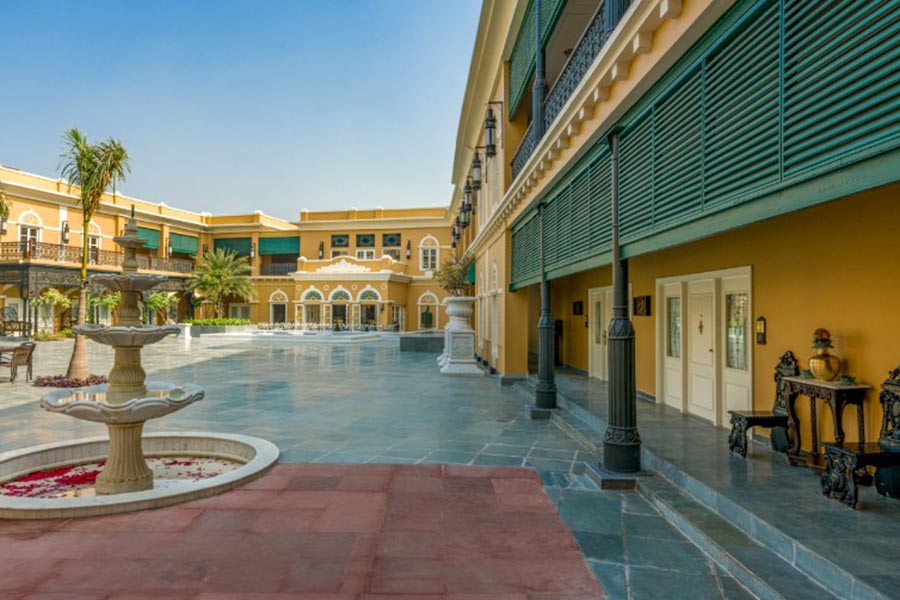
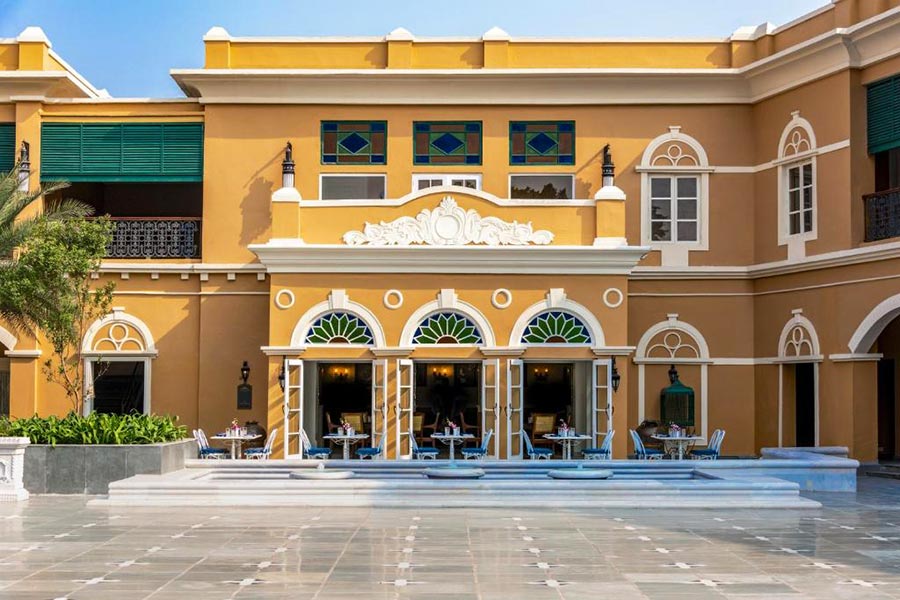
Doars: Riverwood Forest Retrait
Nestled on the fringes of Gorumara National Park, The Riverwood Forest Retreat is a nature lover’s paradise in Northern Bengal. Established in 2008 by Waxpol Hotels and Resorts, our resort in Dooars offers a unique opportunity to immerse yourself in the diverse landscapes of the Eastern Himalayas. It is situated alongside the picturesque River Murti and is renowned for Indian Rhinoceros, Elephants, Indian Gaur, Muntjac, Leopards and a myriad of wildlife. This centrally located resort is the perfect stopover for travellers on their way to Sikkim and Bhutan. Situated about 100 km from Phuentsholing, the entry point of Bhutan, this resort is an ideal choice for those en route. The natural environment surrounding the resort, is a special place for both endemic and migratory birds, and its sustainable ethic also reflects prominently in the designs and decor, allowing guests to admire the forest and its inhabitants in their true glory.


Thimpu: Therma Linca
Therma Linca in Thimpu, strives to bring the best experience to tourists visiting the Himalayas. This resort beautiful art pieces made masterfully by local artists and It combines the beauty of nature and the comfort of modern amenities, which includes a pool and a spa which offers numerous treatments. This special resort represents a serene and peaceful location that will make your trip an enjoyable one, and the best place to relax in a breathtaking Himalayan scenario.


Punakha: Dhensa Boutique Resort
Dhensa sits in the heart of the tranquil and lush Punakha Valley. Flanked by thick pine forests, it overlooks the Punakha River, and hundreds of paddy fields that stair-step down to the valley floor. Its 24 suites are set in 6 cottages, all with private balconies. The spacious interiors are deliberately understated and designed for the modern traveller. This special resort represents an oasis of peace and tranquility to experience a deep relaxation surrounded by incredible lanscapes of one of theof Bhutan’s most beautiful valleys. Here you will have the chance to experience a deep sense of relaxation, also thanks to the Spa which provides traditional Bhutanese treatments and is dedicated to refreshing and rejuvenating guests.


Phubjikha: Gangtey Lodge
The multi-award winning Gangtey Lodge Bhutan offers every comfort and luxury in one of the most remote places in the world. This heritage luxury lodge, discretely positioned near a cluster of farmhouses, is perched above the spectacular Gangtey (Phobjikha) Valley. Its remote location and stunning design in the heart of Bhutan, allows one to take a step back in time, away from the stresses and distractions of modern-day life. The 4th of the 5 valleys that make the Bhutan journey, Gangtey Valley is a protected reserve for the black necked cranes, remaining untouched from the outside world. A journey into the rich culture, mystique and history of Bhutan awaits you. At Gangtey Lodge you will have the opportunity to focus on the 5 keys to wellbeing by immersing you in the culture and natural environment of the Gangtey Valley. From spiritual blessings and community engagement to physical and mental rejuvenation, our authentic experiences enable you to reconnect with yourself and your loved ones.


Paro: Zhiwa Ling
Zhiwa Ling Heritage, a 5-star hotel seamlessly integrated with nature, culture, and tradition , where you can escape the ordinary and immerse yourself in the genuine warmth and comfort typical of Bhutan. Nestled in the charming valley of Paro, Zhiwa Ling Heritage offers a truly exceptional experience, enhancing every aspect of your trip. Here you will have the chance to experience the essence of butan culture by taking part in authentic ecperiences such as a Bhutanese tea ceremony at Heritage’s picturesque tea house, practice yoga and meditation and Witness the Archery and Dart demonstration and learn how to master the traditional Bhutanese games.


TRANSPORT
We will be using comfortable and air-conditioned mini-coach/van throughout the entire trip. A flight from Kolkata to Bagdogra is included.
WHEN TO GO
It is possible to visit Bhutan all year around but the best weather is generally:
Mar–May (spring)/ MidSep–MidNov (autumn). Spring (March April & May) is the most beautiful time of the year, resplendent and ablaze with a spectacular array of bright colours. Also, it is the time to witness the famous Paro tsechu festival. The Paro Tshechu is held every spring and is one of the most colourful and significant events in Paro Dzongkhag (district). Autumn (September, October & November) is lovely with clear and crisp blue skies, providing a grand view of some of the tallest unclimbed mountains in the world. It is the best time for trekking and for travelling. This is instead the right time to assist to the Thimphu tsechu festival!


